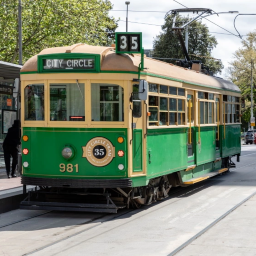- cross-posted to:
- fuck_cars@lemmy.ml
- cross-posted to:
- fuck_cars@lemmy.ml
Do you think Melbourne should bring them back?
Well I imagine much of the "concern" around removing cars from higher density areas like the CBD etc is how will goods/supplies be brought in.
Using the tram network seems like a potentially nice solution. You'd have to make sure the loading and unloading steps don't take up too much time and clog the network, but I can imagine that there'd be solutions for that such as loading in spots off of the main network and unloading well prepared batches that then get wheeled off to their close-by destinations.
Plus, if you go all the way on removing cars in certain areas, increased tram through put might be plausible.
I think it would interfere too much with the regular network to do loading and unloading on busy in-service tracks. Sidings would be a good option, along with dedicated facilities along the route. Maybe the tram depots could be modified to take some minor freight? Lord knows Melbourne could use less cars- it's crazy to me how much of the system operates in mixed traffic! The longest tram network in the world shouldn't be so slow!
I think it would interfere too much with the regular network to do loading and unloading on busy in-service tracks.
I feel it's easy to dismiss prematurely.
- Unloading could done outside of peak traffic times (as is done now with trucks as far as I can tell).
- Dedicated staff on both the tram and on the street could speed up the process significantly, especially if unloading is limited to a few specific sites.
- Batching of goods could go a long way toward limiting the number of unloading points.
- And as you say, "Sidings", if available for both loading and unloading, which is more feasible once cars are off the relevant streets, basically prevents a lot of interference with ordinary passenger trams.
It'd also be interesting to think about this as a distributed system, where many of the passenger trams have portions of their space dedicated to freight storage such that the load of carrying freight is much more smoothly spread out over the network.
Distributed system could work pretty well I think. You could do a kind of roll-on, roll-off system that allows for quick stops.
Yep, that was exactly the sort of thing I had in mind for optimising the unloading times! Unpacking and distributing the contents to specific businesses/people/addresses can be done after the unloading from the tram. EVs similar to cargo bikes could probably make it easier to do as well.
Given how large a tram network is, wouldn't the goods being delivered need to be trucked to a depot, transferred onto a tram, then taken to the final destination? Why not just have a delivery truck?
I'm struggling to see the advantage myself.
I’m struggling to see the advantage myself.
- Already electrified
- Can take the trucks out of destination zones
- Opens possibilities for car/truck-free zones to retain good freight service
A vehicle movement is a vehicle movement though, there's still the same amount of traffic. And with the increasing number of electric trucks around, I think buying an EV truck would be far easier.
These trams were used to transport parts primarily from Preston Depot where they were made to other depots. They doubled as billboards/advertising.


